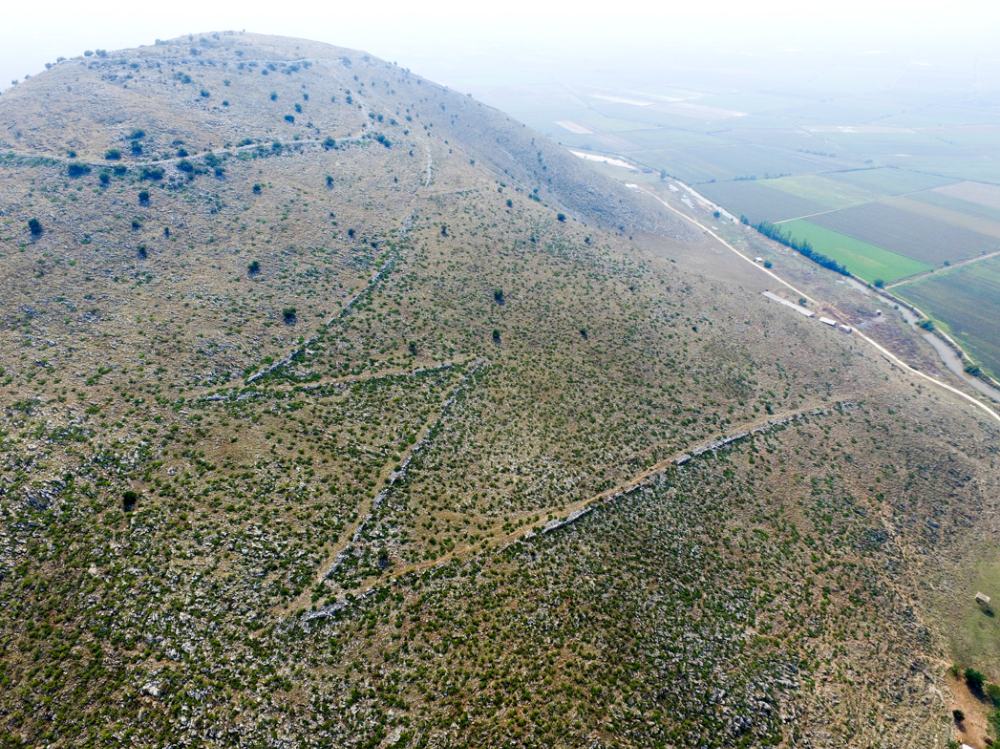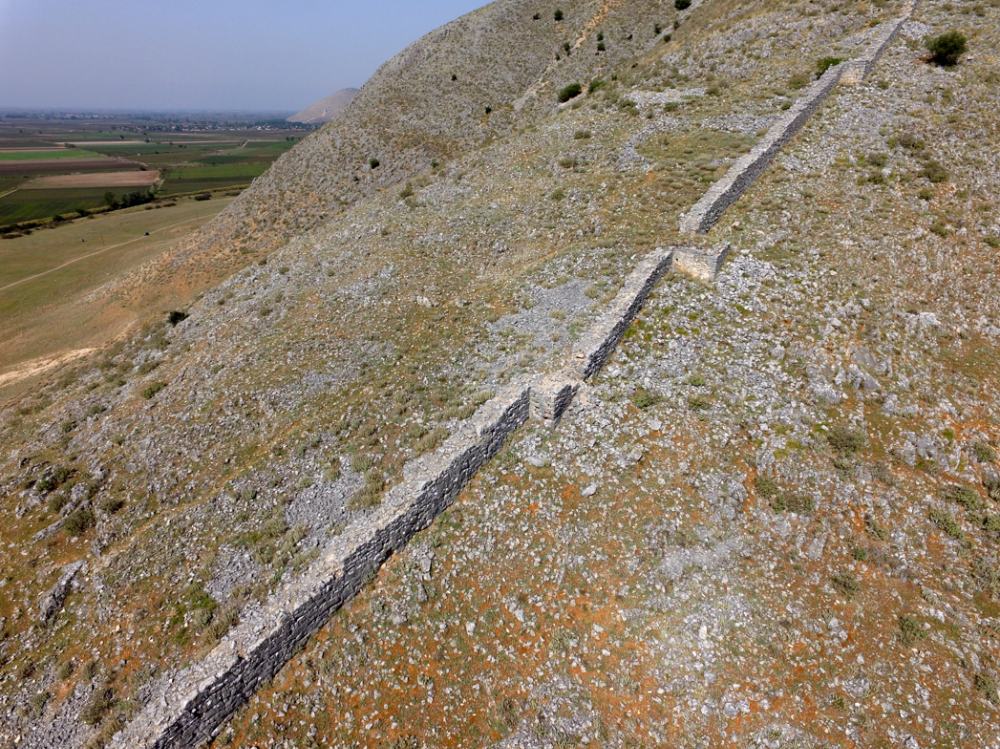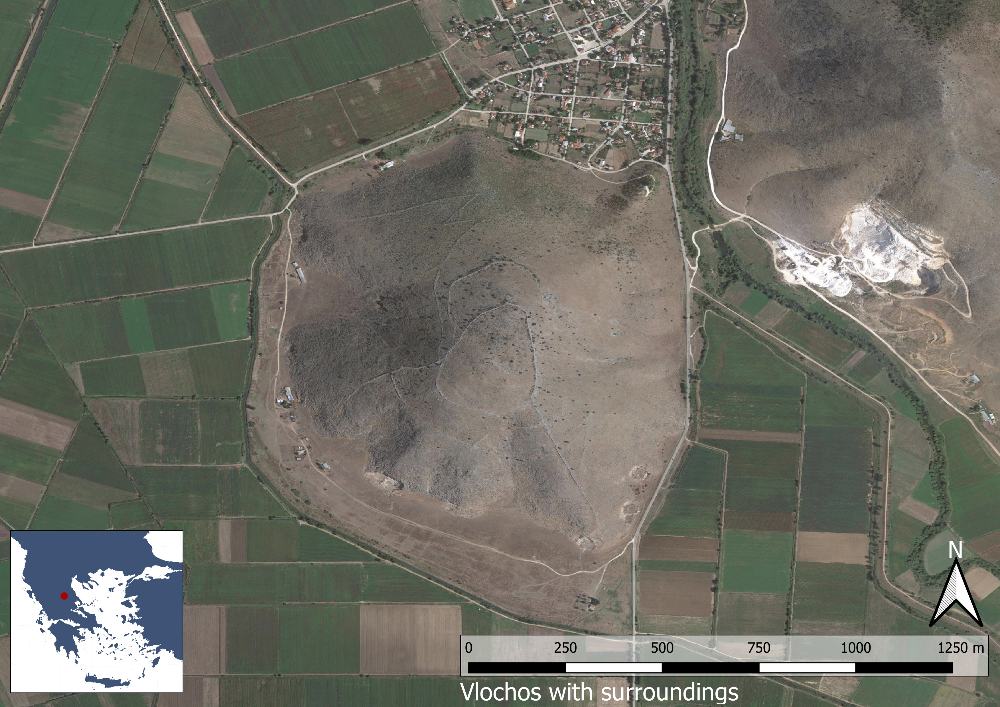Vlochos, Thessaly (2015– ongoing)
Greek-Swedish collaborative fieldwork in Western Thessaly
2020-04-07
The archaeological site of Vlochos is situated three kilometres north of the town of Palamas in western Thessaly, and consists of the large hill of Strongilovouni and its immediate surroundings. An archaeological field programme (The Vlochos Archaeological Project) was carried out here in 2016–2018 as a collaboration between the Ephorate of Antiquities of Karditsa and the Institute, aiming at surveying the extensive multi-period ancient remains found here. Only limited rescue work had been conducted on site prior to the Greek-Swedish programme, which aimed at employing non-invasive methods, including geophysics, high-precision GPS documentation, and extensive aerial photography.

Fig. 2: The hill of Strongilovouni at Vlochos.
The results indicate that the site contains the remains of four major and discrete building programmes, spanning roughly 1200 years of history. On the hilltop there are extensive remains of a large fortification, possibly late Archaic in date, with impressive walls still preserved to more than 2 metres in height. Two monumental-size roads connect this fortified space with the surrounding plains below, ascending the steep slopes in a serpentine fashion.

Fig. 3: Serpentine road leading to the hilltop from the plains.
This fortification was partially destroyed in the fourth century BCE, when a sizeable Classical-Hellenistic city was established in the flat area immediately south of the hill. The remains here have all been covered by erosion masses from the hill and silt from the nearby river Enipeus, but can be discerned with great detail in the geophysical results. Among the buried remains there are clear outlines of streets, squares and houses, as well as the city wall with over 20 towers. This city wall is also well-preserved above ground on the large akropolis on the top of the hill, and must have been an impressive sight in the surrounding area. The large city of this period – the name of which is still unknown – was abandoned at some point in the early second century BCE, possibly as a result of the devastating Second Macedonian War that severely struck this region.

Fig. 4: Fortifications of the Classical-Hellenistic akropolis.
The geophysical survey gave strong evidence for a third urban settlement in the flat area below the hill, with magnetometry producing the clear outlines of what appears to be a Late Roman town. This was much smaller than its Classical-Hellenistic predecessor, and protected by a heavily fortified ring-wall. Exactly when this town was established and later abandoned is unknown at present, as very little of it is visible in the ground.
The fourth and final settlement phase at Strongilovouni consists of the remains of what was possibly a fortified Byzantine village on the southern slopes of the hill. Most of the houses and other buildings have been obliterated due to the strong erosion, but large sections of the Classical-Hellenistic city wall were repaired at this time, and still stand nearly three metres tall on the slope.

Fig. 5: Classical-Hellenistic fortification walls with Byzantine repairs.
At some point in the early Middle Ages, the settlement was abandoned again, and we see no further indications of it being re-inhabited. Today, the site is empty of habitation, except for two small chapels and sheep-pens.
The full results of The Vlochos Archaeological Project will be published in Opuscula, the annual of the Swedish Institutes at Athens and Rome, in late 2020. The institute will continue its collaboration with the Ephorate of Antiquities of Karditsa at this fascinating site, and an application for continued fieldwork permissions has been submitted to the Hellenic Ministry of Culture.
Bibliography
Vaïopoulou, M., H. Whittaker, R. Rönnlund, F. Tsiouka, J. Klange, D. Pitman, R. Potter, L. Shaw, J. Hagan, E. Siljedahl, M. Forssén, S. Chandrasekaran, S. Dandou, V. Forsblom Ljungdahl, A. Pavilionytė, H. Scott-Pratt, E. Schager & H. Manley (submitted). ‘The Vlochos Archaeological Project: Report on the 2016–2018 seasons of Greek-Swedish archaeological work at Vlochos, Thessaly’, Opuscula 13.
Vaïopoulou, M. et al. (forthcoming). ’The Vlochos Archaeological Project 2016–2017: the first two years of Greek-Swedish collaboration at Vlochos, Karditsa Prefecture’, in Αρχαιολογικό Έργο Θεσσαλίας και Στερεάς Ελλάδας 6, ed. M. Mazarakis-Ainian.
Vaïopoulou, M. et al. (forthcoming). ‘Βλοχός’, ADelt 69 Chron.
Parikh, T. 2019. ‘Newsround’, AR 65, 35–36.
Efa 2017. ‘Vlochos 2017 (Record 6788)’, Archaeology in Greece Online.

Fig. 1: Map over the site of Vlochos (Basemap: Google maps satellite image).
Printed: 2025-12-13
From the web page: Swedish Institute at Athens
https://www.sia.gr/en/sx_PrintPage.php?tid=113